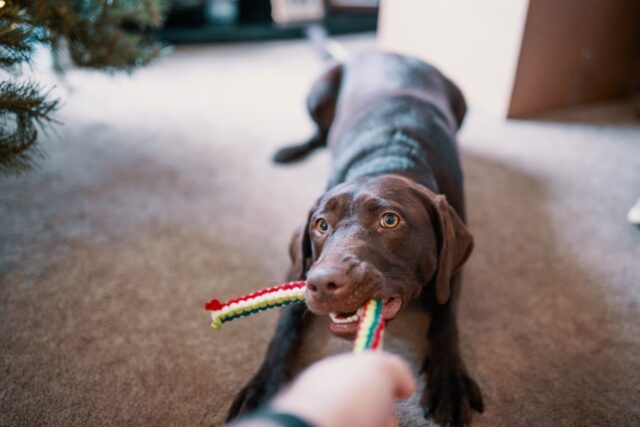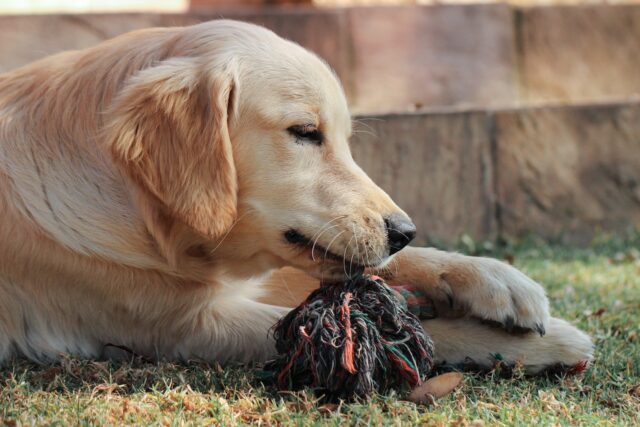With new dogs come lots of fun, joy, and… possibly chewing! But before you train your dog to put an end to this behavior, it’s important to recognize that chewing is not only natural but also has a number of benefits.
Read on to learn everything you should know about chewing, including how to manage it to keep your furniture, shoes, or other items teeth-mark free!
Why dogs love to chew

If you’ve ever watched your dog during their play or downtime, you would’ve already noticed that they love to chew! The most important thing to keep in mind is that they don’t engage in this behavior to spite you.
In fact, there are many different reasons as to why dogs chew. For instance, like infants and toddlers, puppies love to explore their world by using their mouths and also need to relieve teething discomfort. And as they grow older, regular chewing is a natural way to clean teeth, as gnawing scrapes plaque off of teeth, as well as keep it strong and healthy!
It’s also been found that chewing releases endorphins in a dog’s brain. Known as the “happiness chemicals,” a release of endorphins can be compared to the feeling that we humans have when laughing., making feeling a healthy way to ease stress and anxiety.
Other reasons include:
- Lack in training
- No access to safe and appropriate chew toys
- Boredom
- Separation anxiety
- Behavioral issues because of which chewing becomes a coping mechanism
- Excess energy
How to manage dog chewing

Now that we’ve established the importance and benefits of chewing, it’s time to learn the best ways to manage the behavior, to keep your dog (and your home) safe. Ultimately, the secret to managing dog chewing is simply teaching your dog what to chew!
Keep prohibited items out of reach
When you’re training your dog, it’s best to set them up for success as much as you can! To help them learn what is and isn’t okay to chew, don’t make items that fall in the second category easily accessible. Keep clothing, shoes, books, and even trash out of their reach!
Give chew toys that are easily distinguishable from other household items

Related to the first tip, help your dog differentiate between toys they can chew and regular household items. Using old shoes or socks as chew toys will only confuse them!
Supervise your dog until they are only chewing on appropriate items
As with any other training, consistency is key. Avoid accidents and mistakes by keeping your dog on a leash even indoors or inside a crate filled with safe toys to chew. It’s important to remember that crates and cages should never be used as punishment. Rather, they’re meant to become safe spaces for your dog to retreat to or relax in!
Provide sufficient physical and mental stimulation throughout the day
One reason dogs love to chew is to amuse themselves out of boredom! This is why you’ll notice that dogs who get plenty of physical and mental exercise are often the most well-behaved. Learn the amount of exercise your dog needs, which is based on factors such as age, health, and breed characteristics, and make sure to incorporate it into your routine!
If you catch your dog chewing on something they shouldn’t, use the “trade” approach
During training, it’s inevitable that your dog will chew inappropriate items at some point. When this happens, practice getting them to give up the item in exchange for a proper chew toy or a treat. Forcefully removing items from their mouth can lead to their developing guarding behavior or even running away from you!
Don’t chase your dog if they grab an item and run
For dogs, being chased by their owner is fun and counts as play! Instead of running after them and giving them exactly what they want, try calling them to you and offering them a treat or a chew toy.
Soothe teething pain with rubber toys
Teething can cause pain in puppies. To help relieve them of the discomfort, you can try placing a rubber toy in the fridge for a few minutes! This will provide a cooling effect on the gums and teeth, soothing any discomfort.
Set realistic expectations
Don’t expect impressive results after a day of training. It’s important to practice patience towards your dog, as they’ll need time to learn what the appropriate chew toys are and the behavior you expect from them!
What NOT to do during training
Teaching our dog to learn new behaviors can be a tiring process. But as a responsible pet owner, you mustn’t shortcut your way around the training process or worse, punish your dog when they make a mistake!
When teaching your dog to redirect their chewing towards appropriate toys and items, avoid doing the following:
- Showing your dog the damage they did, along with physical or verbal forms of reprimand such as spanking or scolding. While dogs are intelligent, they can’t connect your punishment to a behavior they did hours or even just minutes ago!
- Punishing your dog by using duct tape to keep their mouth closed around a chewed object or tying a damaged item to them. Not only are punishments like these inhumane, but they also teach dogs nothing!
- Leaving your dog in a crate for long periods of time. Again, crates should serve as safe spaces, not a place to lock up your dog when they make a mistake. Using crates as punishment teaches your dog to hate them, which is counterproductive to obedience training!
- Muzzling your dog to prevent chewing. While this is usually done more as a preventive measure, muzzling your dog is only a band-aid solution. It’s still best to train them to identify which items are safe for them to chew!



